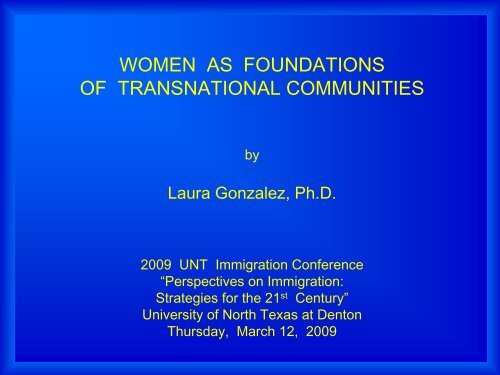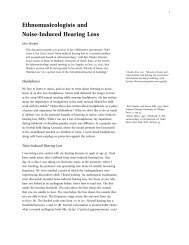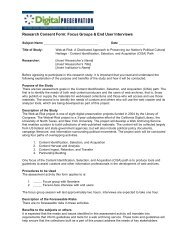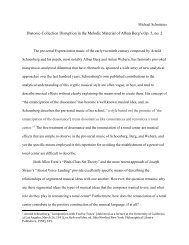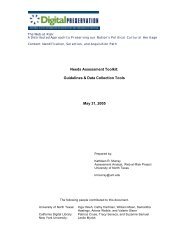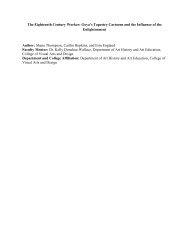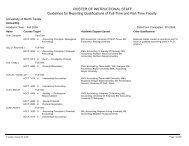Laura Gonzalez - University of North Texas
Laura Gonzalez - University of North Texas
Laura Gonzalez - University of North Texas
- No tags were found...
Create successful ePaper yourself
Turn your PDF publications into a flip-book with our unique Google optimized e-Paper software.
Research Perspective• Ethnographic, Holistic, Genealogical Approaches• Thirty-three Years <strong>of</strong> Ethnographic Research• Binational Research– Mexico (mainly in the State <strong>of</strong> Guanajuato)– United States (California, Pennsylvania, <strong>Texas</strong>)– Guanajuato as a Pot or Seedling where the GUA-PA,GUA-TEX, and CALI-GUA Networks Grow.
International Labor Migration andImmigration as a Binational System• Conceptualizing Labor Migration & Immigration– Labor Migration & Immigration are a BinationalSystem (sometimes International) w/ Origins in Morethan One Country– Binational System Comprised <strong>of</strong> a TransnationalPopulation that Creates and Maintains Social Networksthat facilitate the flow <strong>of</strong> multiple resources (e.g., labor,remittances, information, technology, and culture)across borders
Gender & Labor Migration Research• Existing Research on Gender & Labor Migration– Most Research Views Labor Migration as a MalePhenomenon• Migration through Well-Established Social and Male-BasedNetworks– Recent Research Concentrates on Women as Migrants• Migration through Male-Based Networks– Little Research on the Role <strong>of</strong> Women as Non-Migrantsin the Labor Migration Process
Non-Migrating Women & Labor Migration• Need to Include Non-Migrating Women in Studies <strong>of</strong>Labor Migration• The Role <strong>of</strong> Non-Migrating Women in the Absence <strong>of</strong>Males– Examples: Abigail Quiroz and Marili Lopez• Care <strong>of</strong> Immediate and Extended Family• Resolves Family Problems• Looks After Family-Based Resources, such as Land &Livestock• Manages Remittances
Gender & Immigration• Need for More Research on the Role <strong>of</strong> Women inImmigration– Existing Research views women as secondary players;as responding to male decision making only.– New Research needed on the key roles <strong>of</strong> women in theImmigration Process– Women are anchors; are important to reproducing,transplanting, rooting families and creating newtransnational communities
Women as Anchors in the Binational System• What do I mean by “women as anchors”?• Anchor Processes– Examples: Silvia Tlaseca and Ramona Ortiz• Rooting the family (school, church, health system)• Raising children and grandchildren• Wage labor• Political participation
Conclusions• What we see is not an unilinear system that starts andfinishes, or a social phenomenon that can be explained bypush and pull factors.• What we see is a permanent movement <strong>of</strong> people; asignificant and thriving socio-economic and binationalsystem comprised <strong>of</strong> thousands <strong>of</strong> families located indifferent regions and countries; articulated by kinship andother social ties and the flow or exchange <strong>of</strong> resources.• We see women as the key components <strong>of</strong> this system becausethey anchor the social networks, they root the communities,they allow the reproduction and maintenance <strong>of</strong> the system inmore than one locale by connecting the men with otherentities, by raising children, by taking care <strong>of</strong> the elderly andthe sick, and by transmiting and transforming the culture.
For more information on women and immigration and on the social networks <strong>of</strong>international migrants originally from Guanajuato, working temporarily orpermanently established in <strong>Texas</strong>, California and Pennsylvania, please see:<strong>Gonzalez</strong>, <strong>Laura</strong>2008 “Liderazgo Femenino en el Nivel Transnacional: El Caso del Consejo Consultivo delInstituto de los Mexicanos en el Exterior (CC-IME).” En Co-autoría con Jane Bayes.Traducción al español del artículo publicado en inglés como “New TransnationalOpportunities and Challenges for Women’s Leadership: The Consejo Consultivo delInstituto de los Mexicanos en el Exterior (CC-IME)” en la Revista SIGNS, aJournal <strong>of</strong> Women in Culture and Society. Co-authored with Jane Bayes.Vol 34, Num 1, Autumn by the <strong>University</strong> <strong>of</strong> Chicago Press. pp 37- 41. All rightsreserved 00979740-2008-3401-0007$10.00 con motivo del Simposio sobrePerspectivas Comparativas: Desafíos del Liderazgo Femenino llevado a cabo en laUniversidad de Ümea, Suecia en Julio del 2007. Las dos versiones - en inglés y enespañol -, pueden consultarse en la página de web de la Universidad de Chicago Press(www.journals.uchicago.edu/signs/home.html y la versión en español puede tambiénconsultarse en las páginas de web de la Fundación Comunitaria del Bajio(www.fcbajio.org) y del Oak Cliff Center for Community Studies(www.oakcliffccs.org).
2006 “Women and Globalization in Mexico.” In Women, Democracy, andGlobalization in <strong>North</strong> America. A Comparative Study. Co-authored withJane Bayes, Patricia Begne, Lois Harder, Mary Hawkesworth, and <strong>Laura</strong>MacDonald. New York: Palgrave. pp 107-130.2001 “Mexico/U.S.Migration and Gender Relations: The Guanajuatense Communityin Mexico and the United States.” In Kelly, Mae Rita, Jane H. Bayes, Mary E.Hawkesworth, and Brigitte Young, eds, Gender, Globalization, and Democratization.Rowman and Littlefield Publishers, pp. 75-94.2000 “Guanajuatenses and Other Mexican Immigrants in the United States: NewCommunities in Non-Metropolitan and Agricultural Regions.” Julian SamoraResearch Institute Short Monograph Series, Number 47, Michigan State <strong>University</strong>,East Lansing, Michigan. Co-authored with Victor García, 10 pp.1998 Coordinator and de facto editor, Proceedings <strong>of</strong> the International Colloquium onMexican Migration to the United States (Memoria del Coloquio InternacionalSobre Migración Mexicana a Estados Unidos) Joint publication among Gobiernodel Estado de Guanajuato, La Universidad de Guanajuato and Consejo Estatal de Población, 36chapters, 392 pp.1998 “Presentación: Guanajuatenses en Estados Unidos” y “Las Redes y Organizacionesde Migrantes Guanajuatenses en Estados Unidos” en Memoria del ColoquioInternacional Sobre Migración Mexicana a Estados Unidos.pp. 4-8 y 225-232.
1997 “Redes de Migrantes Guanajuatenses” y “Migrantes. Quiénes son y cuántosson?” En Alternativas. Revista de la Procuraduría de los DerechosHumanos de Guanajuato. Año 2, Num 4, 8 pp.1997 “The Mariana Case, an Alternative Model to Study Migration.” Cuadernosdel CICSUG, Número 12, 30 pp. Reproduced and widely distributed forteaching purposes by colleagues at the <strong>University</strong> <strong>of</strong> California, SantaBarbara, UC Berkeley, UC Riverside, Princeton, Michigan State <strong>University</strong>,Indiana <strong>University</strong> <strong>of</strong> Pennsylvania and other universities in Canada as wellas in Mexico. Translated from the Spanish version originally published in1994 in Revista Regiones, listed below as “Los Migrantes y los Censos dePoblación.”1994 “Los Migrantes y los Censos de Población, un Enfoque Antropológico.”Revista Regiones Vol. II No. 4, abril-julio, pp. 127-144.1992 Respuesta Campesina a la Revolución Verde en El Bajío (PeasantResponse to the Green Revolution in the Bajio). Mexico: UniversidadIberoamericana Press, 319 pp.
QUESTIONS ?Dr. <strong>Laura</strong> <strong>Gonzalez</strong>gnzlzlr@sbcglobal.netSenior Research ScientistResearch InstituteIndiana <strong>University</strong> <strong>of</strong> Pennsylvania


